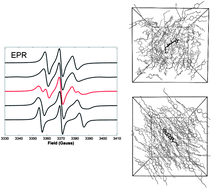Molecular dynamics and EPR spectroscopic studies of 8CB liquid crystal†
Abstract
We report successful simulation of motional

* Corresponding authors
a
School of Chemistry, University of East Anglia, Norwich, NR4 7TJ UK
E-mail:
v.oganesyan@uea.ac.uk
Fax: +44 (0)1603-592003
b Department of Chemistry, Durham University, University Science Laboratories, South Road, Durham, DH1 3 LE UK
We report successful simulation of motional

 Please wait while we load your content...
Something went wrong. Try again?
Please wait while we load your content...
Something went wrong. Try again?
F. Chami, M. R. Wilson and V. S. Oganesyan, Soft Matter, 2012, 8, 6823 DOI: 10.1039/C2SM25429H
To request permission to reproduce material from this article, please go to the Copyright Clearance Center request page.
If you are an author contributing to an RSC publication, you do not need to request permission provided correct acknowledgement is given.
If you are the author of this article, you do not need to request permission to reproduce figures and diagrams provided correct acknowledgement is given. If you want to reproduce the whole article in a third-party publication (excluding your thesis/dissertation for which permission is not required) please go to the Copyright Clearance Center request page.
Read more about how to correctly acknowledge RSC content.
 Fetching data from CrossRef.
Fetching data from CrossRef.
This may take some time to load.
Loading related content
